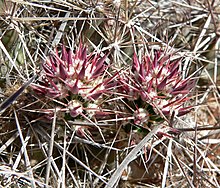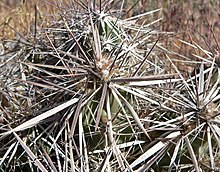
Summary
Grusonia is a genus of opuntioid cacti (family Cactaceae), originating from the North American Deserts in Southwest United States and northern Mexico, including Baja California. Authors differ on precise boundaries of the genus, which has been included in Cylindropuntia.[2] Corynopuntia, also known as club chollas (or "perritos" in Mexico), is now a synonym, with the genus originally being described by Knuth in 1935. Molecular phylogenetic studies suggest that it should be included in Grusonia, a view accepted by Plants of the World Online as of June 2021[update].
| Grusonia | |
|---|---|

| |
| Grusonia parishiorum | |
| Scientific classification | |
| Kingdom: | Plantae |
| Clade: | Tracheophytes |
| Clade: | Angiosperms |
| Clade: | Eudicots |
| Order: | Caryophyllales |
| Family: | Cactaceae |
| Subfamily: | Opuntioideae |
| Tribe: | Cylindropuntieae |
| Genus: | Grusonia Rchb.f. ex Britton & Rose[1] |
| Type species | |
| Grusonia bradtiana | |
| Species | |
|
See list | |
| Synonyms | |
| |

Etymology edit
The name Corynopuntia comes from the Greek coryne, meaning ‘club’, and refers to the club-shaped branch segments, so "club opuntia", club cholla.
Description edit
These opuntioid plants grow in low opuntioid cushions, consisting of rather ovoid or slightly clavate segments, from 1 up to 25 cm long, tuberculate, not ribbed, glabrous. Spines are strong, very prickly and dangerous, covered on their margins by fine denticles, with epidermal tunica (sheath) at the apex only. Flower generally yellow, few species have pink to deep magenta flower. Fruit narrowly obconic to ellipsoid, fleshy at first but soon drying, yellow to brownish, often stinky, generally full of glochids and spiny. Seed yellowish white to brownish, suborbicular or flattened. Most of the species belonging to Corynopuntia show a very similar morphology, apparently with few differences, so this genus was little studied. Recent in-depth field and lab researches are improving the knowledge about these plants, showing the existence of many undescribed species.[3][4][5][6][7][8] Whilst Corynopuntia members are morphologically similar one to each other, the mentioned research studies highlighted that wild club chollas rarely naturally hybridize when they grow sympatric.
Taxonomy edit
The genus Corynopuntia was first set up in 1935[9] as a segregate from Opuntia, but was reduced to sectional rank by Benson in 1969 and slightly elevated again to a subgenus by Bravo in 1972. In 1999, Anderson included Corynopuntia in his enlarged concept of Grusonia.[10] Pioneering DNA work by Dickie in 1997, subsequent molecular data from Wallace and Dickie (2002)[11] and Griffith (2003),[12] and seed micromorphology studies by Stuppy (2002),[13] suggested that Corynopuntia should be reinstated as a distinct genus. This was accepted by the Cactaceae Consensus Group in 2006.[14] However, a 2016 molecular phylogenetic study of the tribe Cylindropuntieae showed that when separated, Corynopuntia and Grusonia were polyphyletic, and so combined them as Grusonia.[15] This is accepted by Plants of the World Online as of June 2021[update].[16]
Distribution edit
The members of the genus Corynopuntia are native of South-Western United States (California, Arizona, Nevada, New Mexico and Texas) and Northern Mexico (States of Baja California, Baja California Sur, Sonora, Chihuahua, Coahuila, Nuevo Leon, Durango, Zacatecas, San Luis Potosì, Tamaulipas), from 60 up to 2000 m above the sea level.
Ecology edit
Club chollas grow generally in very dry areas, on flats or gentle slopes, fully exposed to the sunlight or sometimes under sparse bushes. Depending on the species, they grow on sandy, loamy or gravelly soil. The stem segments of several species readily break off when touched: this is an important method of vegetative reproduction for these cacti, since the finely toothed spines stick to animal skin or fur, then the segment can be transported even for miles. The barbed spines can remain embedded in the skin, causing discomfort and sometimes injury.
Species edit
Species of the genus Grusonia according to Plants of the World Online As of January 2023[update]:[17]
| Image | Scientific name | Distribution |
|---|---|---|
| Grusonia aggeria (Ralston & Hilsenb.) E.F.Anderson | United States (Texas) to Mexico (Coahuila) | |
| Grusonia bradtiana (J.M.Coult.) Britton & Rose | Mexico | |
| Grusonia bulbispina (Engelm.) H.Rob. | Mexico | |
| Grusonia clavata (Engelm.) H.Rob. | New Mexico | |
| Grusonia deinacantha (D.Donati) Majure, M.A.Baker & Cloud-H. | Mexico (Coahuila). | |
| Grusonia densispina (Ralston & Hilsenb.) Pinkava ex Rebman | United States (Texas) to Mexico | |
| Grusonia emoryi (Engelm.) Pinkava | United States (Texas, Arizona, New Mexico) to Mexico | |
| Grusonia grahamii (Engelm.) H.Rob. | United States (Texas, New Mexico) to Mexico (Jalisco) | |
| Grusonia guccinii (D.Donati) Bárcenas & H.M.Hern. | Mexico (Coahuila). | |
| Grusonia halophila (D.Donati) Majure, M.A.Baker & Cloud-H. | Mexico (Coahuila) | |
| Grusonia invicta (Brandegee) E.F.Anderson | Mexico (Baja California). | |
| Grusonia kunzei (Rose) Pinkava | United States (Arizona, California) and Mexico (Baja California Norte, Sonora). | |
| Grusonia marenae (S.H.Parsons) E.F.Anderson | Mexico (Sonora). | |
| Grusonia moelleri (A.Berger) E.F.Anderson | Mexico (Coahuila, Durango, San Luis Potosí) | |
| Grusonia parishiorum (Orcutt ex Britton & Rose) Pinkava | United States (Arizona, California, Nevada ) | |
| Grusonia pulchella (Engelm.) H.Rob. | United States(California, Nevada, Utah) | |
| Grusonia reflexispina (Wiggins & Rollins) E.F.Anderson | Mexico (Sonora) | |
| Grusonia robertsii Rebman | Mexico (Baja California Sur). | |
| Grusonia schottii (Engelm.) H.Rob. | United States (Texas) to Mexico | |
| Grusonia vilis (Rose) H.Rob. | Mexico |
References edit
- ^ IPNI Plant Name Query Results for Grusonia, The International Plant Names Index, retrieved 2012-04-17. The IPNI entry notes that Britton & Rose incorrectly gave the authority as "F. Reichenbach", an error repeated by Anderson (2001, p. 342).
- ^ Anderson, Edward F. (2001), The Cactus Family, Pentland, Oregon: Timber Press, ISBN 978-0-88192-498-5, pp. 342–343
- ^ Rebman, J. (2006) A new club cholla, Grusonia robertsii (Cactaceae) from Baja California Sur, Mexico. Madrono 53(3):278-281
- ^ Donati, D.(2010) Una nuova, eccezionale specie appartenente al genere Corynopuntia Knuth: Corynopuntia guccinii sp. nov., in Piante Grasse 30(3): 115-119
- ^ Donati, D. (2011) Nuovo studio sul gruppo clavata del genere Corynopuntia Knuth: riscoperta di C. agglomerata e descrizione di C. bulbispina subsp. basileocephala subsp. nov., in Piante Grasse 31(1): 17
- ^ Donati, D., in Piante Grasse 32(2): 7. 2012
- ^ Donati, D. (2013) New data from the habitats of Corynopuntia marenae and Corynpuntia reflexispina, in Cactusworld 31(1): 55-60
- ^ Donati, D. (2014) Technical and taxonomical notes on Corynopuntia robertsii. Cactus and Succulent Journal of America 86(2): 73-75
- ^ Knuth, F. M. (1935) Corynopuntia. Kaktus-ABC. Gyldendals Forlagstrykkeri, Copenhagen.
- ^ Anderson, E. F. (1999) Some nomenclatural changes in the Cactaceae, subfamily Opuntioideae. Cact. Succ. J. (US) 71: 324–325
- ^ Wallace, R. S. and Dickie, S. J. (2002) Systematic implication of chloroplast DNA sequence variation in subfam. Opuntioideae (Cactaceae). Succ. Pl. Res. 6: 9–24.
- ^ Griffith, M. P. (2003) Grusonia pulchella classification and its impacts on the genus Grusonia: morphological and molecular evidence. Haseltonia 9: 86–93
- ^ Stuppy, W. (2002) Seed characters and generic classification of Opuntioideae. Succ. Pl. Res. 6: 25–58.
- ^ Hunt, D. (2006) The New Cactus Lexicon. DH Books, Millborne Port
- ^ Bárcenas, Rolando T. (2016). "A molecular phylogenetic approach to the systematics of Cylindropuntieae (Opuntioideae, Cactaceae)". Cladistics. 32 (4): 351–359. doi:10.1111/cla.12135. PMID 34740297. S2CID 86139803.
- ^ "Grusonia K.Schum". Plants of the World Online. Royal Botanic Gardens, Kew. Retrieved 2021-06-19.
- ^ "Grusonia F.Rchb. ex Britton & Rose - Plants of the World Online". Plants of the World Online. Retrieved 2023-01-19.
External links edit
- Media related to Grusonia at Wikimedia Commons
- Data related to Grusonia at Wikispecies


